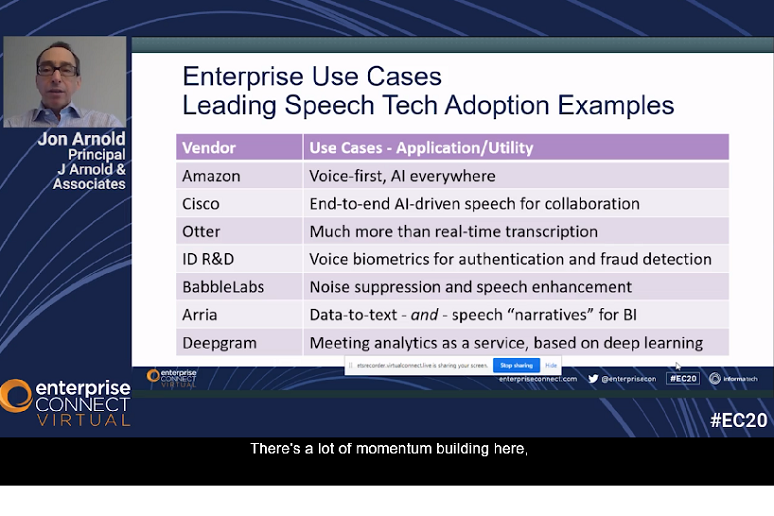Voice technology has come a long way from its humble analog beginnings. With speech technologies, enterprises can voice-enable meeting rooms, support after-hour customer service, and much more. And with newer speech technologies — like those highlighted in the “
Enterprise Speech Technologies: Innovations and Use Cases” session at Enterprise Connect Digital Conference & Expo — this is just the tip of the iceberg of what they can enable.
Kickstarting his presentation, Jon Arnold, principal analyst at J Arnold & Associates, gave us a quick history lesson on speech technologies. In the past, analog telephony was sought out solely because it enabled person-to-person communications. As it evolved into the digital era, voice services started to provide enterprises with valuable data (i.e., length of call), Arnold said. Moving into the future, speech technologies will provide enterprises with more AI-infused communications capabilities. "It's not just you speak, and the chatbot responds," Arnold said. AI-infused chatbots are going to be doing things like reminding you of important tasks.
Speech technology has historically followed the "consumer trends lead, enterprises follow" trajectory, Arnold said. For instance, smart speakers like Amazon Echo and Google Home gained popularity for home use, and then were adapted for enterprise use cases. But now, we’re seeing the rise of use cases for speech technologies around the requirement for touchless interactions, including in meeting rooms and other collaboration environments, Arnold said.
During the session, Arnold highlighted seven speech tech providers and what they’re offering:
- Amazon — Like Google and Samsung, Amazon initially launched Alexa as a smart speaker (Echo) but has since added the voice interface to a variety of earbuds, monitors, headsets, and other endpoints, Arnold said.
- Cisco — Last year, Cisco acquired Voicea and tucked the startup’s voice AI technology into the Cisco Webex experience, Arnold said. With the Webex Assistant, users have a host of in/post-meeting capabilities, including meeting transcriptions.
- Otter.ai — Starting first with real-time transcription, Otter.ai is now looking into other areas of AI use, for instance, automated meeting summaries and the ability to search a conversation for keywords, Arnold said.
- ID R&D — Just as enterprises have leveraged biometrics like face recognition, now they’re turning to voice as another way to authenticate a person's identity, via services like those by ID R&D, Arnold said.
- BabbleLabs — Noise suppression has become this year's feature, and BabbleLab is one of the providers in the space, Arnold said. With this service, enterprises can reduce the background noises (dogs barking, keyboard clicks, paper ruffling, etc.) of voice and video meetings, Arnold explained.
- Arria — Arria converts business intelligence data, including from voice channels, into business reports. The enterprise puts in the variables, and then Arria generates the reports in text and speech versions, Arnold said.
- Deepgram — Usable in the contact center and in team collaboration, this speech recognition company analyzes voice inputs to decipher things like sentiment, Arnold said.
When it comes to building a case for speech technology in the enterprise, IT decision-makers should first consider what they're trying to accomplish and then thoroughly research the various offerings against your objectives, Arnold said. Objectives are typically either business-based (automation and cost reduction) or employee-based (productivity gains and employee engagement), and a different set of vendors are suited to each, he said.
Speech technology is just an application and not a full solution, and not all products perform the same, Arnold said. What’s more, the vendor landscape is complex and fluid, he added. Some speech services are built into a platform (Amazon or Google), and others are purpose-built for a specific task (ID R&D's biometric capabilities). In concluding, Arnold repeated advice echoed on many other IT projects: "If getting speech right is important to you, keep in mind that not all platforms are the same, [and] you’ve really got to do your homework."









